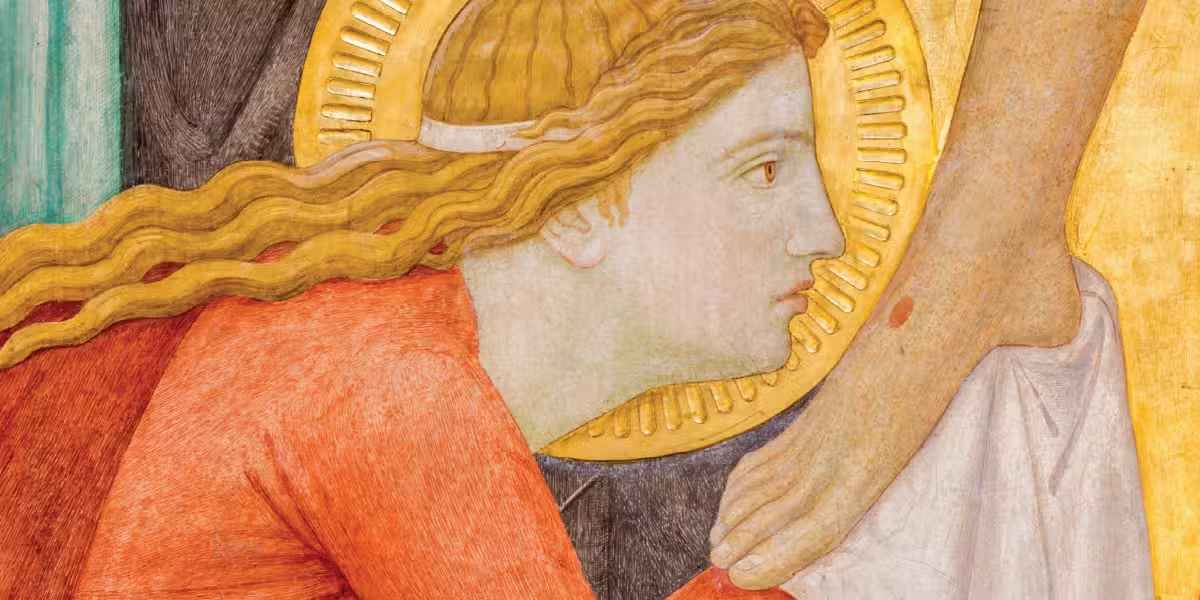One early Christian writing describes Mary as equal to the apostles, perhaps even a leader among them. It claims that anyone with spiritual maturity has the ability and authority to teach and interpret the Gospel.
Not all the books written about Jesus or the life of the early Church made it into the New Testament. In fact, most of them did not.
There were many other Gospels besides Matthew, Mark, Luke, and John written in the early decades of the Christian era. Many more epistles than those composed by Paul, John, Peter, Jude, and James. Other books called “Acts” besides the Acts of the Apostles. Several more revelations than the Book of Revelation.
These other Scriptures were rejected by the early Church and condemned as heretical. Over time, the Church came to believe that the entire truth about Jesus was to be found only in the 27 books that make up the New Testament. All others were rejected.
But there’s another way of thinking about these other Scriptures, also known as apocryphal books. From the standpoint of history, they shed light on how a variety of Christian communities understood Jesus, his mission, and those who accompanied him. They illustrate the great diversity of beliefs and practices in the earliest days of the Christian era.
Let’s take a peek at one of these other Scriptures—the Gospel of Mary.
Mary Magdalene as Prophet and Sage
Mary Magdalene is the primary character in the Gospel that bears her name. She is portrayed as a leader of the apostles. She consoles them and teaches them, and she is the recipient of a personal vision from Jesus. Levi (Matthew) even declares to his fellow apostles that Jesus “loved her more than us.”
Mary was likewise depicted as an important follower of Jesus in the Gospel of Luke: “Afterward he journeyed from one town and village to another, preaching and proclaiming the good news of the kingdom of God. Accompanying him were the Twelve and some women who had been cured of evil spirits and infirmities, Mary, called Magdalene, from whom seven demons had gone out, Joanna, the wife of Herod’s steward Chuza, Susanna, and many others who provided for them out of their resources” (8:1–3). Mary Magdalene must have been a wealthy, successful woman in order to have been a financial supporter of Jesus’ movement.
Mary Magdalene’s prominent role in both the Gospel of Mary and the Gospel of Luke discredits the traditional misunderstanding that she was a “repentant prostitute.” For centuries Mary Magdalene was mistakenly identified as the “sinful woman” in Luke 7:36–50; she approaches Jesus at a banquet, washes his feet with her tears, dries them with her hair, kisses them, and puts perfume on them. Over time this woman became identified as a prostitute and as Mary Magdalene.
The Gospel of Mary was virtually unknown until 1896, when a copy of it was discovered in a manuscript in Cairo, Egypt. No complete copy of the Gospel of Mary exists—we have only about half of it. The author of the Gospel is anonymous—as is the case with many other books either in or outside the New Testament. Some scholars say it may have been written by a woman.
The Gospel seems to have been written sometime between the years 100 and 150 CE, for two reasons. First, it highlights Mary’s role as a prophet and a visionary. The ministry of prophecy and the ministerial role of women were still respected in the first half of the second century. Second, in the Gospel there is a conflict between Mary and Peter. This indicates it was written at a time when Peter’s authority in the Christian movement was not yet fully established.
How Is Sin Described?
The Gospel opens with a discussion between Jesus and his disciples after the resurrection. He is asked, “Will matter be destroyed or not?” Jesus answers that at the present time material and spiritual realities are interwoven with each other, but that in the end this will not be so. Each reality will return to its own original state, its “root.” The material world will pass away, and the spiritual world will return to God. This means the human body will also pass away, because it has no real spiritual value.
Peter then asks, “What is the sin of the world?” Surprisingly, Jesus answers, “There is no sin, but you create sin when you mingle as in adultery, which is called sin.” What does that mean? The Gospel does not define sin in terms of individual wrong actions. Rather, sin is a mixing of the evil material world with the world of spirit. Jesus continues: “That is why you become sick and die, for you love what deceives you.” Attachment to the material world is seen by Jesus both as adultery and sickness—as sin.
Jesus finishes by saying: “Peace be with you. Receive my peace. Be careful that no one leads you astray with ‘Come over here!’ or ‘Go there!’ The Child of True Humanity is within you. Follow him!” Jesus is warning the apostles not to be misled by false religious leaders. Spiritual advancement can be achieved only by following “the Child of True Humanity,” their own deepest spiritual selves. Jesus also warns the disciples not to blindly follow laws and regulations, which are external, established only to control and mislead them.

Jesus commissions the disciples to go and preach the Gospel, and then he departs.
But the apostles do not follow Jesus’ command to go and preach. They begin to weep, saying: “How can we go to the Gentiles and preach the Gospel of the Kingdom and the True Child? If they did not spare him, will we be spared?” They are afraid that if they preach, they might be killed just as Jesus was.
At this moment Mary Magdalene steps up, kisses the apostles, and says, “Do not weep and do not grieve or be irresolute, for his grace will be fully with you and will protect you. Rather, let us praise his greatness. He prepared us and made us truly human”—that is, truly spiritual. The apostles are relieved to hear Mary’s words, and they begin to discuss Jesus’ teachings.
Doubting the Woman
Peter now addresses her: “Sister, we know that the Savior loved you more than other women. Tell us the words of the Savior that you remember, which you know and we do not. We have not heard them.” Peter is clearly acknowledging the special relationship Mary has with Jesus, and her authority as a “sister”—an apostle.
Mary answers: “What is hidden from you I will reveal to you.” She begins the account of her vision by recalling the question she asked Jesus: “Lord, how does a person see a vision, through the soul or through the spirit?” Jesus responds: “Where the mind is, there is the treasure.” The mind is the divine part of the self, linking the soul to God. Through his teachings, Jesus informs the mind of its true spiritual nature. But individuals must discover their own divinity—the “Child of True Humanity”—within. Believers must overcome their ignorance of their false, material selves and come to know their true, spiritual selves.
Mary then describes what Jesus told her about the “journey of the soul” and how to defeat the four evil powers that seek to keep the soul trapped in the world and ignorant of its true spiritual nature.
The encounter with the first power is missing from the manuscript. The second power, Desire, tries to keep the soul from ascending by claiming that it belongs to the material world. But the soul knows better. The soul then encounters the third power—Ignorance. Ignorance thinks the soul is material and, therefore, bound by the wickedness of human passions. The soul overcomes the false claims of Ignorance. The soul then moves to the fourth power—Wrath, with seven powers of its own. Wrath tries to mislead by charging the soul with murder, because it has cast off the material body.
“When Mary said this, she fell silent, since the Savior had spoken to her all of these things.” At this point the apostle Andrew breaks in. He declares that Mary Magdalene could never have received these teachings from the Savior because they sound strange to him.
Peter, who just minutes before had asked Mary to explain the vision, now turns on her: “Did he really speak to a woman secretly, without our knowledge, and not openly? Are we to turn and listen to her? Did he prefer her to us?” Peter is irritated that Mary claims to have received knowledge directly from Jesus, while he and the other apostles had not.
Mary, taken aback by the words of Andrew and Peter, begins to cry, and says, “My brother, Peter, what do you think? Do you think I concocted this in my heart or am I lying about the Savior?”
Levi quickly comes to Mary’s defense. He scolds Peter for being a hothead and for treating Mary as an enemy. He says, “If the Savior made her worthy, who are you to reject her? Surely the Savior knows her very well. That is why he loved her more than us.”
Levi scolds the apostles, telling them they should be ashamed of themselves. He concludes by saying they should all “put on the perfect person and be with him as he commanded us, and we should preach the Gospel, without making any rule or law other than what the Savior said.”
The apostles—surely including Mary Magdalene—“go out to proclaim and to preach.” Here the Gospel comes to an abrupt end.
Differences with the New Testament
While the Gospel of Mary includes some details that are also found in the New Testament Gospels, it differs from them in a number of significant ways.
First and foremost, the Gospel of Mary does not say that the suffering and death of Jesus are the path to eternal life. Jesus’ teachings, not his passion, death, and resurrection, point the way to salvation. His teachings enable believers to recognize their true spiritual identity, the “Child of True Humanity.” They come to understand that they possess the very spark of divinity within them.
Second, the Gospel depicts Mary Magdalene as a peer of the other apostles—as having equal status with them. She addresses them as “brothers,” and they call her “sister.”
Even more, Mary Magdalene is portrayed as a leader of the apostles. Only she receives a personal vision from Jesus. She possesses greater spiritual maturity than the others. Levi goes so far as to say that Jesus loves her more than them.
Third, the Gospel of Mary challenges the claim in the early Church that the bishops were the Church’s only legitimate authority figures and the only legitimate interpreters of the message of Jesus. The Gospel makes the claim that anyone with spiritual maturity has the ability and authority to teach and interpret the Gospel.
Fourth, the Gospel takes issue with the view that Peter was the “rock” upon which Jesus built his Church. In the Gospel of Mary, Peter is portrayed very differently—as a hotheaded and jealous man whose authority is challenged successfully by Mary and Levi.
The Gospel of Mary is one of many Scriptures that was not accepted by the Church for inclusion in the New Testament. But that doesn’t mean these other Scriptures should be ignored or treated as simply wrong. Texts such as the Gospel of Mary shed light on what certain Christian communities sincerely believed and taught about Jesus and his message of salvation. The core of our Christian belief system obviously comes from the canonical books of the New Testament. But books like the Gospel of Mary can also inform, enlighten, and inspire us on our journey of faith.









1 thought on “St. Mary Magdalene: Leader and Visionary ”
So interesting and beautiful. Thank you for this message!